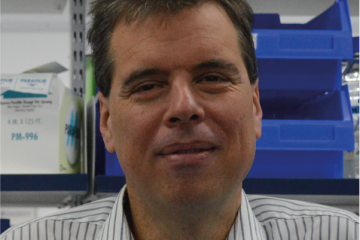Modelling O-GlcNAc transferase intellectual disability syndrome in Drosophila

At a glance
R
- Replacement
Contents
Overview
Why did we fund this project?
This award aims to replace the use of mice and rats in studies of intellectual disability by generating transgenic Drosophila lines with mutations in OGT, a glycosylation enzyme.
The addition of the sugar O-GlcNAc to specific amino acids on cytosolic and nuclear proteins is catalysed by OGT. Mutations in OGT are known to cause intellectual disabilities but whether this can be attributed to the altered behaviour of the OGT enzyme, the resulting change in O-GlcNAc levels or the loss of O-GlcNAc on specific amino acids within a protein is not well understood. There are a range of rodent models used to investigate O-GlcNAc, one of the more common methods administers an inhibitor via intraperitoneal injection to systemically elevate O-GlcNAc levels. These animals are then used in a range of procedures specific to the clinical phenotype of interest, including intellectual disability. Transgenic animals can also be used to determine the role of O-GlcNAc at specific amino acid sites, which can require a large number of animals to successfully generate the desired mutation and a new transgenic line for every amino acid site of interest. Drosophila has the potential to be used as an alternative animal model as OGT, and many of the biochemical pathways it is involved in are highly conserved from humans to Drosophila.
The student will use CRISPR/Cas9 to generate Drosophila lines carrying mutations in OGT equivalent to those found in patients with intellectual disabilities as new tools for the community. Morphological and behavioural studies will then be carried out to determine the impact of the mutations on neuronal function. Specific proteins will also be edited to prevent O-GlcNAc addition to determine the mechanisms underlying the phenotype. The student will also develop skills in immunohistochemistry, proteomics and transcriptomics.
Application abstract
O-Linked N-acetylglucosamine (O-GlcNAc) transferase (OGT) is an essential enzyme which is solely responsible for the dynamic cytosolic and nuclear O-GlcNAcylation of serine and threonine residues on over 1000 proteins. This modification is removed by a single enzyme, OGlcNAc hydrolase (OGA). Both proteins are essential for mammalian embryonic and perinatal survival, respectively. Recently, mutations in OGT have been identified as causal in intellectual disability syndrome (ID), however, the exact mechanism leading to this disorder are unknown.
This studentship will endeavour to identify how two hypothesised mechanisms contribute to OGT-ID: altered O-GlcNAcylation and altered OGT:protein interactions. To achieve this the student will use Drosophila melanogaster as a model system. OGT is highly conserved from humans to Drosophila, along with many of its interactors, such as the mitochondrial motility protein Milton and periodicity proteins involved in the circadian rhythm. The student will dissect the molecular mechanisms leading to ID through achieving 4 aims:
- The student will generate fly lines carrying OGT mutations equivalent to those found in patients using a CRISPR/Cas9 system. We have already demonstrated the viability of this approach successfully generating a fly line carrying a patient mutation.
- These fly lines will then be assayed for a number of neuronal phenotypes, both morphological and behavioural. The former will be achieved using a combination of genetic and antibody labelling to visualize gross brain morphology, mushroom body morphology (the associative memory region of the fly brain, and an excellent model to study axonal morphology), and dendritic morphology using class IV dendritic arborisation sensory neurons. To assay neuronal function through behaviour, a light-off habituation test will be employed. This leverages the natural escape response of Drosophila to a sudden reduction in light, in nature signalling the presence of a predator, and measures their neuronal adaptation to the repetition of this stimulus without the ordinarily associated consequence. In preliminary experiments, we have found a decrease in habituation in OGT mutant flies.
- The specific mechanisms driving the observed phenotypes will be dissected through proteomic and transcriptomic approaches. Quantitative O-GlcNAc proteomics will be conducted through enrichment of O-GlcNAcylated proteins with a catalytically inactive OGA we have used for this purpose in the past. The role of individual proteins or modified sites will be probed through genetic approaches, ablating induvial proteins to assess genetic interactions or individual modified sites by mutating modified residues to alanine. An additional approach which can be employed is the mutation of identified sites to cysteine. We have found this results in a SGlcNAc modification which is not hydrolysable by OGA, elevating the stoichiometry of the modification on a single residue. This is a technique which has never before been employed in vivo, and we would assay in the context of rescuing (some of) the phenotypes seen in OGT mutant flies.
- The student will also attempt to rescue observed phenotypes by globally manipulating O-GlcNAc levels, genetically by knocking out OGA (which unlike in mammals is tolerated in the fly) and pharmacologically through the use of OGA inhibitors or glucosamine supplementation.
All aforementioned approaches have been shown to result in elevated OGlcNAcylation. Their efficacy at rescuing phenotypes will be assayed through administration at various developmental stages providing insight into the reversibility of the ID in adult organisms. Together, this studentship will answer many fundamental questions about the role of OGT mutations in the development of ID, establish Drosophila as a model for the functional analysis of single site O-GlcNAc modifications, and guide future research we will conduct on a mammalian system.
Publications
References
- Omelková M et al. (2023). An O-GlcNAc transferase pathogenic variant linked to intellectual disability affects pluripotent stem cell self-renewal. Dis Model Mech 16(6):dmm049132. doi: 10.1242/dmm.049132
- Fenckova M et al. (2022). Intellectual disability-associated disruption of O-GlcNAc cycling impairs habituation learning in Drosophila. PLoS Genet 18(5):e1010159. doi: 10.1371/journal.pgen.1010159
- Mitchell C et al. (2022). Bioinformatic prediction of putative conveyers of O-GlcNAc transferase intellectual disability. J Biol Chem. 298(9):102276. doi: 10.1016/j.jbc.2022.102276
